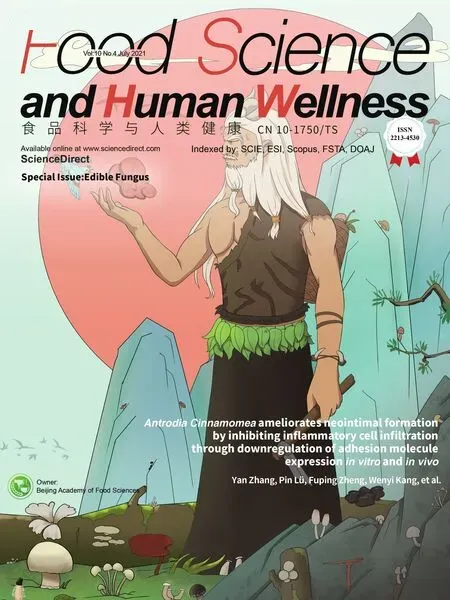Advances in research on chemical constituents and pharmacological effects of Paecilomyces hepiali
2021-05-24AkangDanYujiaHuRuyanChenXiangyangLinYongqiTianShaoyunWang
Akang Dan, Yujia Hu, Ruyan Chen, Xiangyang Lin, Yongqi Tian*, Shaoyun Wang*
School of Biological Science and Technology, Fuzhou University, Fuzhou 350108, China
Keywords:Paecilomyces hepiali Chemical constituents Pharmacological effects
ABSTRACT Paecilomyces hepiali is a fungus with edible and pharmaceutic value, isolated from Ophiocordyceps sinensis.Its main bioactive constituents contain alkaloids, cyclic dipeptides, steroids, organic acids, and polysaccharides.Due to the huge development potential of P.hepiali in the field of food and medicine, it has been developed into a variety of products that cater to the needs of the public.In this paper, the chemical constituents and their pharmacological effects of P.hepiali are reviewed, which can provide reference for the development and application of P.hepiali.
1.Introduction
Ophiocordyceps sinensiswas classifi ed from the genusCordycepsin the Clavicipitaceae family in 2007 and was classified into the genusOphiocordycepsin the Ophiocordycipitaceae family [1,2].Because of its good health care and disease prevention functions,O.sinensishas been actively excavated and used as a precious Chinese medicinal material since ancient times [3].However, due to the strict growth environment, low reproduction rate and large market demand,O.sinensishas been overexcavated and natural environment has been damaged [4,5].In addition, due to the heavy metal content ofO.sinensisseriously exceeding the standard, the State Administration for Market Regulation of China issued a notice stoppingO.sinensisfrom being used in dietary supplement in March 2018 [6].Therefore,O.sinensishas to withdraw from the market of dietary supplement.In order to make up for the large market gap, it is particularly important to find alternatives toO.sinensis.
The National Health Commission of the People’s Republic of China stipulated that only 2 myceliums produced byO.sinensisrelated strains could be used in dietary supplement, one of them isPaecilomyces hepiali.This fungus has been included in the list of fungi strains used in health food, which promulgated by the China Food and Drug Administration [7].P.hepialiwas isolated from naturalO.sinensis(stiffworm), which belongs to the fungusPaecilomyces Bainin the Moniliaceae family [8-10].The main bioactive constituents of fermentation mycelium ofP.hepialiandO.sinensisare the most similar in allO.sinensisrelated fungi.Studies had shown that they both contained cordyceps, polysaccharides, adenosine and cordycepic acid, and their inorganic element composition were basically the same [11,12].Even in some biological activities, the artifi cial fermentationproduct ofP.hepialiwas superior toO.sinensis[13-15].
On the basis of previous work, this article reviews the chemical constituents and the pharmacological effects ofP.hepiali, aiming to further research and develop the resource ofP.hepiali.
2.Chemical constituents
At present, the research on the chemical constituents ofP.hepialimycelium concentrate mainly on alkaloids, cyclic dipeptides, steroids, flavonoids, organic acids, and polysaccharides, which are the important material basis forP.hepialito exert its pharmacological effects [7,16,17].(Figs.1-5).
2.1 Alkaloids
2.1.1 Nucleosides
Nucleosides are the basic element of biological cells to maintain life activities, which participate in the metabolic process of DNA, and have a variety of biological activities, such as antitumor, anti-viral and gene therapy [18].To date, more than 10 nucleosides (1-10) have been obtained fromP.hepiali.Ge et al.[19]reported the presence of adenosine (1) and cordycepin (2) in the methanol extract ofP.hepialimycelium (PHME).Cao et al.[20,21]obtained 5 nucleosides: 2’-O-methyladenosine (3), 5’-O-acetyl-9-β-arabinofuranosyl adenosine (4), 3’-O-(β-D-glucosyl) adenosine (5), 2’-O-methyluridine (6) and 2’-deoxythymidine (7) from then-butanol extract ofP.hepialimycelium.Zhang et al.[22]detected uridine (8), cytidine (9) and guanosine (10) in the fermentation broth ofP.hepiali, which were similar to the result of Yang et al.[23].Detection of samples from the 4 main producing areas ofO.sinensisfound that the samples from Naqu City,
Tibet Province, China, contained the highest cordycepin content, reaching 0.03% [24].While the content of cordycepin detected in the fermented mycelium ofP.hepialiwas 0.44%, which was nearly 15 times higher than that ofO.sinensissamples [19].Moreover, some researchers increased the cordycepin content in the originalP.hepialiby 2.560 times by breeding the strains and optimizing the culture conditions [25].
2.1.2 Other alkaloids
Recently, 3 other types of alkaloids: 4-[formyl-5-(hydroxymethyl)-1H-pyrrol-1-yl]butanoic acid (11), 4-[formyl-5-(methoxymethyl)-1Hpyrrol-1-yl]butanoic acid (12)N-phenylethylace-tamide (13) were also isolated from the mycelium ofP.hepiali[7,21].
2.2 Cyclic dipeptides
Cyclic dipeptides, are formed by the intraamide cyclization of two amino acids, which have anti-tumor, immunomodulatory and other biological activities [26].Wu et al.[27]separated and purified then-butanol extract of the methanol extract ofP.hepialimycelium and obtained 8 cyclic dipeptides (14-21), which were characterized as cyclo (Pro-Val) (14), cyclo (Pro-Phe) (15), cyclo (Pro-Ile) (16), cyclo (Pro-Leu) (17), cyclo (Leu-Val) (18), cyclo (Val-Phe) (19), cyclo (Val-Ala) (20) and cyclo (Ala-Phe) (21), respectively.Hong et al.[7]isolated 3 cyclic dipeptides from ethanol extract ofP.hepialimycelium (22-24), namely cyclo (Leu-Trp) (22), cyclo (Ile-Trp) (23) and cyclo (Val-Trp) (24).Cao et al.[20,21]reported 5 cyclic peptides (25-29), cyclo(Asn-Ile) (25), cyclo(Asn-Phe) (26), cyclo (4-hydroxy-Pro-Phe) (27), cyclo(Ser-Phe) (28) and cyclo (Ala-Tyr) (29) from then-butanol extract ofP.hepialimycelium.
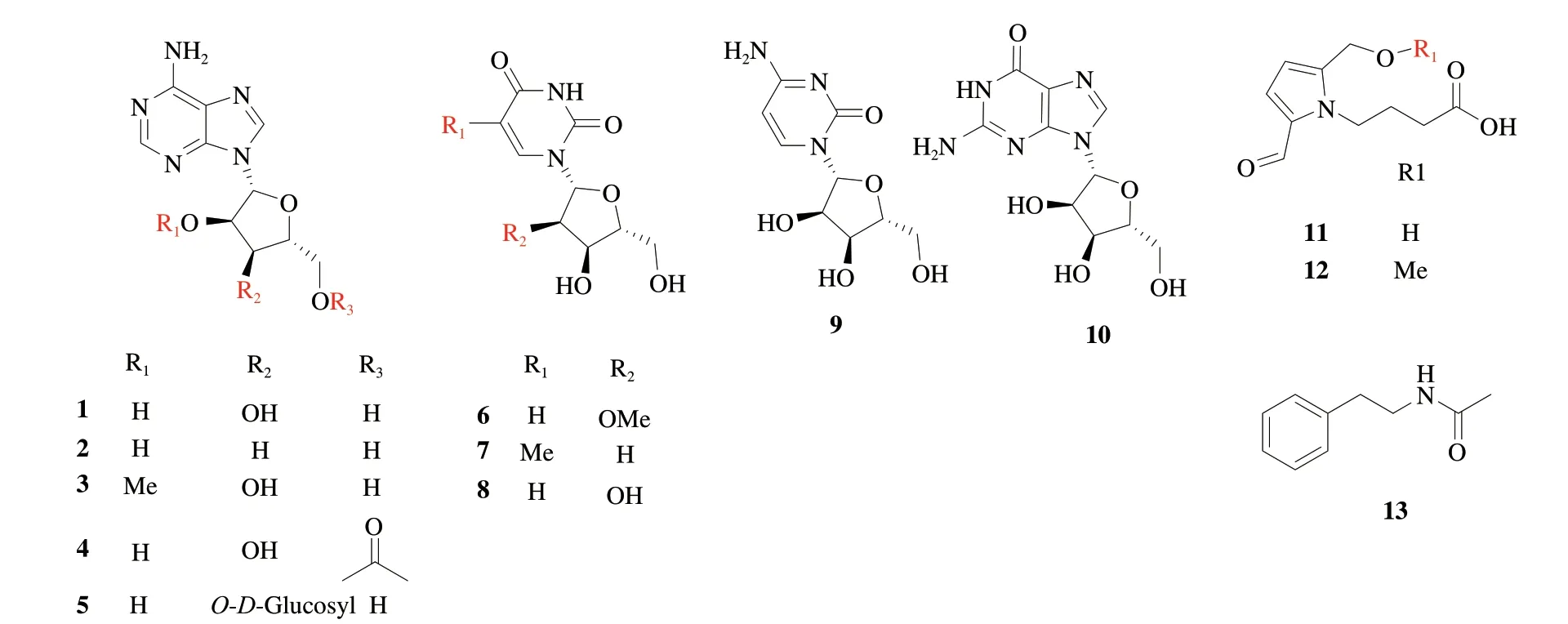
Fig.1 Alkaloids isolated from the P.hepiali.

Fig.2 Cyclic dipeptides isolated from the P.hepiali.
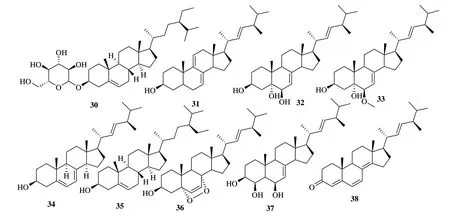
Fig.3 Steroids isolated from the P.hepiali.
2.3 Steroids
Steroids are widely found in animals, plants, insects and microorganisms.They have a synergistic regulatory effect on the metabolism of organisms [28,29].Hong et al.[7]purified 4 steroids from the ethanol extract ofP.hepialimycelium, and namely daucosterol (30), regosterol D (31), cerevisterol (32) and 6-O-methylcerevisterol (33).Fan et al.[30]isolated 5 steroids from the mycelium ofP.hepiali, characterized as ergosterol (34),β-sitosterol (35), ergosterol peroxide (36), cerevisterol (37) and 4,6,8(14),22(23)-tetraen-3-one-ergostan (38).As an bioactive characteristic sterol, the content of ergosterol inP.hepialiwas 15.65 mg/g,which was much higher than its content inO.sinensis[31].
2.4 Flavonoids
Flavonoids have been previously reported in plants, but rarely in fungi.They have a variety of biological activities like anticancer, anti-inflammatory, antibacterial and improving Alzheimer’s disease [32].At present, 4 flavonoids isolated fromP.hepiali,and identified as 4’’-O-methyldaidzin (39) and 4’’-O-methylglycitin (40), 6-hydroxyl-4’’-O-methyldaidzin (41) and 3’-hydroxylgenistein (42).
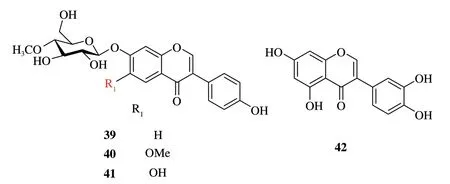
Fig.4 Flavonoids isolated from the P.hepiali.
2.5 Organic acids
Organic acids have a variety of bioactive functions, like promoting gastric juice secretion, helping digestion, enhancing immunity and anti-tumor [33].Fan et al.[30]found elaidic acid (trans9-octadecenoic acid) (43) and linoleic acid (9,12-otadecadienoic acid) (44) from the mycelium ofP.hepiali.Zhang et al.[22]analyzed the composition of organic acids ofP.hepiali, including palmitoleic acid (45), linolenic acid (46), myristic acid (47), palmitic acid (48), 14-methyl-pentadecanoic acid (49), heptadecanoic acid (50), arachidic acid (51) and docosanoic acid (52).Hong et al.[7]isolated 5-hydroxyl-methylfuroic acid (53), succinic acid (54) fromP.hepiali.
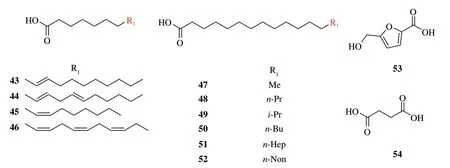
Fig.5 Organic acids isolated from the P.hepiali.
2.6 Polysaccharides
Polysaccharides isolated fromP.hepialihave a variety of biological activities, which has attracted the attention of researchers [34-36].At present, more than 10 polysaccharides (55-65) have been isolated from the fermentation broth and fermented mycelium ofP.hepiali.They have different molecular weights, monosaccharide compositions and connection mode (Table 1) [34-37].The relationship between the chemical structure and pharmacological activity of polysaccharides isolated fromP.hepialihas always been the focus of researchers, but so far, due to the complex structure of polysaccharides, it is difficult to completely analyze the structure of polysaccharides.Therefore, research in this area has not made a breakthrough, and many research results are one-sided.
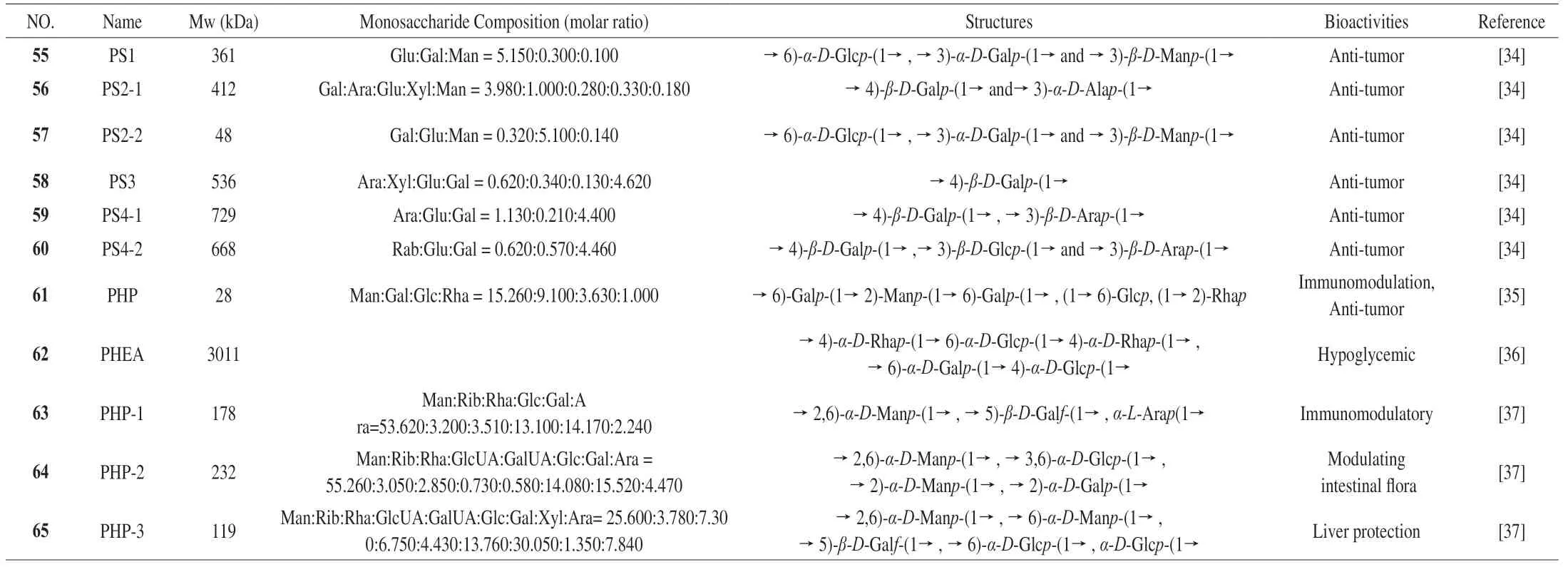
Table 1 Polysaccharides isolated from P.hepiali.
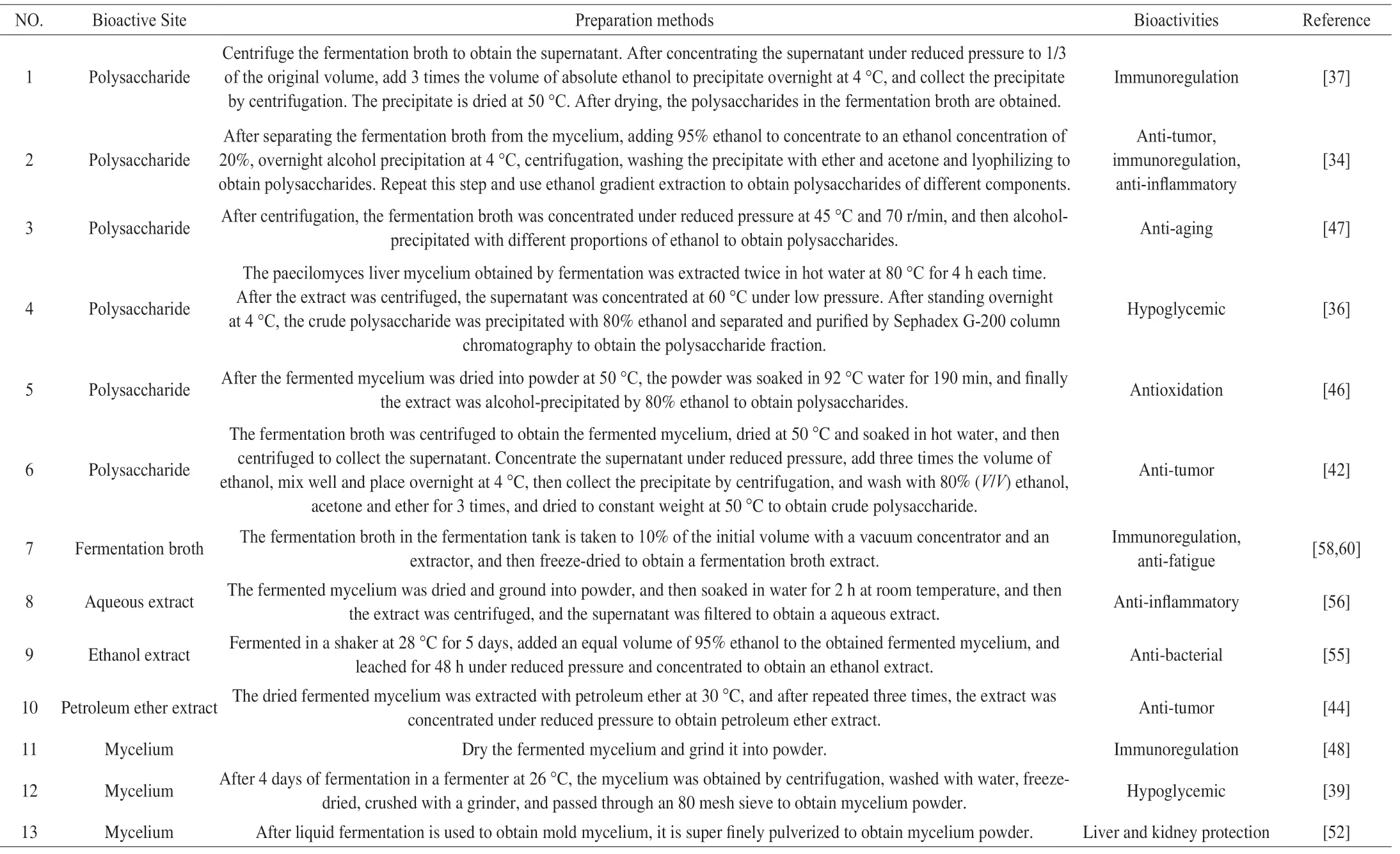
Table 2 Bioactive ingredients of P.hepiali and their preparation methods.
3.Biological activities (Table 2 )
3.1 Hypoglycemic effect
The polysaccharides ofP.hepialihad the hypoglycemic effect by regulating nuclear factor-κB (NF-κB) signal transduction [36].In vivostudies also showed that the activities of antioxidant enzymes, the ability of pancreatic cells to resist oxygen free radicals and the secretion of insulin increased after feeding the fermented mycelium ofP.hepialito diabetic rats [38-40].In addition to this, a follow-up survey of 60 diabetic patients showed that the fermented mycelium ofP.hepialicould reduce diastolic blood pressure and proteinuria excretion in patients with diabetic nephropathy, which further proved the hypoglycemic effect ofP.hepiali[41].These data suggested thatP.hepialicould be an important resource for research and development of hypoglycemic drugs or functional foods.
3.2 Anti-tumor effect
The extract ofP.hepialihas been found to have significant inhibitory activity on MCF-7, Hela, A549, HepG2, H22 and SMMC-7721 cells [42-45].Thesein vivoandin vitroexperiments demonstrated thatP.hepialimight inhibit the progression of cancer patients by influencing the physiological characteristics of cancer cell proliferation and apoptosis, and had potential anti-metastasis effects of cancer.It may be a relatively mild and effective method to control tumor progression by ingesting natural anti-tumor factors in food.Obviously,P.hepialiis a potential screening target.
3.3 Antioxidant and anti-aging effects
Polysaccharides ofP.hepialihad significantin vivoantioxidant activity in mice by increasing the activity of superoxide dismutase (SOD), glutathione peroxidase (GSH-Px), catalase (CAT) and total antioxidant capacity (T-AOC) in the serum [46].Other study showed that polysaccharides ofP.hepiali(P60) could prolong the average lifespan of drosophila by slowing down the oxidation effect [47].However, current research on its antioxidant and anti-aging mechanisms is not comprehensive enough.
3.4 Immunomodulatory effect
Zhang et al.[48]found that the fermented mycelium ofP.hepialisignificantly stimulated the proliferation and transformation of mouse splenic lymphocytes, and promoted the carbon scavenging effect of mouse monocyte macrophages, resulting in enhancing the immune function of mice.Studies also showed that the mechanism of the immunomodulatory activity ofP.hepialiethanol extract might be related to the suppression of CD4+T cell responses to reduce inflammation and protectβcells [49].Based on this, it can be speculated that the immune regulation mechanism ofP.hepialiis mainly to stimulate the proliferation of immune cells and immune factors.
3.5 The effects of protecting kidney and liver
After feeding liver and kidney injury model mice with fermented mycelium ofP.hepiali, their weight and the damaged kidney and liver gradually recovered [50,51].Further research showed that the liver and kidney protection mechanisms ofP.hepialimainly included inhibiting xanthine oxidase (XOD) activity in the liver and overexpression of urate transporter (URAT1) in the kidney, as well as reducing the expression of collagen-IV (Col-IV), fibronection (FN) and os-teopontin (OPN) to reduce the synthesis of extracellular matrix (ECM), which has a positive effect on the protection of liver and kidney [52,53].
3.6 Antibacterial activity
Studies had shown that the ethanol extract of the fermented mycelium ofP.hepialipronounced inhibitory effect on 19 of the 26 pathogenic indicator bacteria and the hot water extract of the fermented mycelium ofP.hepialialso had significant inhibitory effect on the growth of food borne pathogens [54,55].Therefore,P.hepialican be used as a potential source of antibacterial food additives.
3.7 Anti-inflammatory activity
The water extract of the fermented mycelium ofP.hepialisignificantly reduced the production of nitric oxide (NO) in RAW264.7 cells, the expression of inducible nitric oxide synthase (iNOS) and pro-inflammatory cytokines [56].Wang et al.[38]showed that the regulation of macrophage inflammatory system byP.hepialimainly depends on controlling the release of inflammatory factors.This suggested thatP.hepialimight inhibit the release of inflammatory factors by inhibiting the NF-κB and activating protein 1 (AP-1) signaling pathways, thus playing an anti-inflammatory role.Thus,P.hepialimay be a good screening resource for discovering new antiinflammatory molecules.
3.8 Anti-fatigue effects
The freeze-dried fermentation broth ofP.hepialicould significantly up-regulate the levels of SOD and GSH-Px in mouse serum and liver, and effectively increased the expression levels of phosphorylated 5’-adenosine phosphate activated protein kinase (p-AMPK), so as to improve the antifatigue ability of mice [57,58].Xu et al.[59]found that fermented mycelium ofP.hepialicould significantly reduce the number of electric shocks in mice during training, and improve fatigue-related biochemical indicators.
4.Safety evaluation
As a medicinal and edible fungus,P.hepiali, its safety also needs to be confirmed in many aspects.Studies had shown that the acute oral toxicity median lethal dose (LD50) of fermented mycelium ofP.hepialito mice was greater than 10.000 g/kg·bw, and the results of the Ames test, micronucleus test and sperm abnormality test were all negative, which proved that theP.hepialiwas a virtually non-toxic substance [61,62].An 8-week randomized double-blind clinical trial consisting of 79 volunteers showed that after oral administration of 1.680 g/day fermented mycelium extractofP.hepiali, the volunteers’ vital signs and anthropometric parameters were within the normal range [63].All these evidences proved thatP.hepialiwas non-toxic.Compared with naturalO.sinensis,P.hepialidoes not need to worry about the accumulation of harmful heavy metals like arsenic.The safety evaluation results ofP.hepialisupport its development and application as dietary supplement and medicine.
5.Conclusion
The literature showed that more than 65 chemical components have been isolated fromP.hepiali, including the main bioactive compounds such as nucleosides, sterols and polysaccharides.Throughin vitroandin vivoexperiments proved that they have a variety of biological activities like hypoglycemic, anti-tumor, and immunomodulatory.However, the current research on the chemical components ofP.hepialiis not enough.The research on its bioactive constituents and pharmacological effects mainly focuses on the crude extracts of water and alcohol in the fermentation products, most of which are crude polysaccharides.In addition, most studies on the bioactive of polysaccharides still remain in the macro description of biological indicators and speculations on partial mechanisms based on the above results, while there are few studies and verifications on microscopic gene expression and overall metabolic mechanisms.Moreover, reports on the activity research and pharmacological effects of monomer compounds are also considerably limited.
In order to make up for these shortcomings, we believe that the subsequent research work is suitable for expansion in the following aspects: (1) Structure-bioactivity analysis of bioactive ingredients ofP.hepiali, and optimization and improvement of fermentation methods to improve the separation and purification efficiency of main bioactive compounds like cordycepin.(2) By studying the positive regulation and cascade relationship ofP.hepialitranscription factor, and by knockout, overexpression or combination engineering, to improve the yield of cordycepin and other bioactive components.(3) Strengthen the biological activity, pharmacological mechanism, and metabolic mechanism research of monomer compounds formP.hepiali, especially in the field of chronic diseases prevention and neurological protection.
Declaration of Interest Statement
All authors declare that no conflict of interest exists.
Acknowledgements
This work was financially supported by the Natural Science Foundation of Fujian Province of China (Grant No: 2019J05032).
杂志排行
食品科学与人类健康(英文)的其它文章
- Antioxidative and hepatoprotective activities of a novel polysaccharide (LSAP) from Lepista sordida mycelia
- Antioxidant and hepatoprotective effects of Hypsizygus ulmarius polysaccharide on alcoholic liver injury in rats
- Therapeutic effect of natural melanin from edible fungus Auricularia auricula on alcohol-induced liver damage in vitro and in vivo
- The normal cell proliferation and wound healing effect of polysaccharides from Ganoderma amboinense
- The triterpenoids-enriched extracts from Antrodia cinnamomea mycelia attenuate alcohol-induced chronic liver injury via suppression lipid accumulation in C57BL/6 mice
- Isolation of Pleurotus florida derived acetylcholinesterase inhibitor for the treatment of cognitive dysfunction in mice
